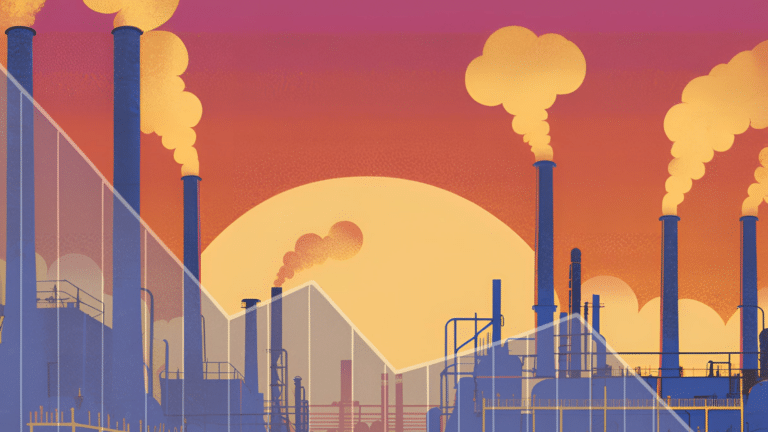Big banks predict catastrophic warming, with profit potential
Morgan Stanley, JPMorgan and an international banking group have quietly concluded that climate change will likely exceed the Paris Agreement's 2 degree
Current Access Level “I” – ID Only: CUID holders, alumni, and approved guests only
Op-eds & Essays by Jason Bordoff • April 08, 2020
In April 1986, U.S. Vice President George H.W. Bush traveled to Saudi Arabia with a request for King Fahd, the country’s ruler at the time: Please raise the price of oil. After falling around 60 percent over the course of a few months, cheap oil was becoming a “two-edged sword for America,” Bush explained. Consumers might enjoy low prices at the gas pump, but evaporating revenues for U.S. oil producers undermined America’s own oil supply, and thus its national security.
That was the last time the White House publicly sought more expensive oil—until now. U.S. President Donald Trump has been pushing Saudi Arabia and Russia to cut output in the hopes that less crude on the market will raise oil prices, which have fallen by two-thirds since the start of the year. A low oil price threatens an already teetering U.S. shale oil sector with a wave of bankruptcies and job losses.
All eyes are therefore on OPEC and its allies, which will meet by videoconference on Thursday to discuss the way forward—followed by an emergency meeting of G-20 energy ministers on Friday, where the United States will be represented as well. It was at the last meeting of OPEC and key non-OPEC producers in Vienna on March 6 that Russia refused to go along with a Saudi proposal for deeper production cuts. The subsequent surge in Saudi supply set off a vicious price war that has seen the price of oil briefly fall below $20 a barrel.
The primary reason for the drop in oil prices, however, is the stunning collapse in oil consumption as the global economy has ground to a virtual standstill in the face of the coronavirus pandemic. April oil consumption is projected to be up to 25 percent lower than during the same month last year, a decline not seen in nearly a century. With no market for refined products such as gasoline, diesel, and jet fuel, crude storage is quickly filling up on land and at sea. As the world runs out of places to put oil, prices may even go negative in some markets, as not all companies will be able to shut their production down fast enough and may have to pay customers to take the oil off their hands.
That a U.S. president would once again advocate for higher oil prices was unthinkable just a decade ago, when the United States still imported 60 percent of its oil. Since then, thanks to new technologies enabling the extraction of oil from shale, the United States has become the world’s largest oil producer. It no longer needs to import oil on a net basis. (It imports certain grades of oil needed by its refineries, while exporting others.)
This growth has delivered many benefits, including jobs and investment, but a price collapse also causes much more pain, balancing or offsetting the benefits to consumers from lower oil prices. This is especially true right now, when consumers on lockdown are largely unable to spend what they save at the gas pump.
And so, in the span of just a few weeks, Trump has shifted from celebrating low prices as a boon for U.S. consumers to decrying that the U.S. oil industry was under attack. He has trumpeted an alleged deal with Saudi Crown Prince Mohammed bin Salman to cut oil output, which, as Trump tweeted, “will be GREAT for the oil & gas industry.” At the same time, U.S. senators have threatened Saudi Arabia with massive economic pressure, including anti-dumping investigations, tariffs, trade restrictions, sanctions, antitrust action, cuts in U.S. military aid, and the removal of American forces from the kingdom.
Both Moscow and Riyadh have said they will cut production only if the world’s other major producers join them. That may no longer be so far-fetched. Concern about low oil prices has become so acute that the Texas Railroad Commission, which has the power to set quotas in the U.S. state with the highest oil production, has already called a hearing for April 14 to discuss possible quotas.
For anyone who recalls the long history of American politicians bashing OPEC for high gasoline prices, it boggles the mind that OPEC might join forces not just with Russia, but also with Texas and other U.S. states to prop up prices. In reality, however, there are five reasons why any such global oil cartel, or any lasting agreement to raise prices, is unlikely.
First, there is no effective mechanism for so many nations to come together to cut output. Instead, oil producing and oil consuming nations have formed two different organizations. Following the shock of the 1973 Arab oil embargo, the major oil-consuming nations formed the International Energy Agency and agreed to hold emergency oil stockpiles. Today, the agency includes such nations as India and China as associate members.
Oil producers have OPEC, which has also evolved by cooperating with non-OPEC countries such as Russia. Yet many major producers remain outside OPEC, most importantly the United States, which now finds itself in the unique position of being both the world’s largest oil producer and its largest consumer, yet lacks an effective forum for dialogue with other producers. The G-20, which includes the United States, Saudi Arabia, and Russia, might seem like a good setting for major producers to make a historic declaration of cooperation on Friday, but as an organization that includes oil consumers with diverging interests, the G-20 is not fit for the purpose.
Second, even if a forum for all major producers to negotiate production levels existed, the United States has little to bring to the table, because the federal government does not directly control how much oil the country produces. U.S. oil production levels are determined by thousands of economic decisions of individual firms, not government fiat. That is why the United States has already signaled that it cannot commit to government-mandated production levels at Friday’s meeting of G-20 energy officials, even if it can point to projected production declines and call them “cuts.”
In theory, some U.S. states, such as Texas and Oklahoma, have the authority to curtail production. While the Texas Railroad Commission—which actually served as the model for OPEC—may yet decide to resurrect quotas, many oil companies remain opposed. Implementing quotas oil well by oil well is also complicated, as we know from past experience, when these kinds of quotas were part of a byzantine system of allocation programs, price controls, and import restrictions. Having pushed for years to deregulate energy markets and allow free trade to work, the industry may come to regret more state control, especially as any such control will likely be seized by climate activists and their allies in politics as a basis for production cuts and export restrictions.
Third, markets work. The U.S. oil sector will be cutting production whether or not the government requires it. U.S. output is projected to fall by at least 1 million barrels per day by the end of 2020, and perhaps by much more next year if prices remain depressed. Shale oil is also different because it has a short production cycle—output can fall more quickly than conventionally produced oil but also rebound more quickly as well, which helps stabilize market imbalances.
While the price collapse is painful for many companies and workers, it will also force financial restructuring, weeding out the weakest, most heavily indebted firms. Many shale oil resources will still be economically attractive, leaving it to companies with stronger balance sheets to produce the oil as prices recover. The result will be a stronger shale oil industry, albeit one growing at a slower rate than in the past.
Fourth, diplomacy remains an effective tool to encourage Saudi Arabia and Russia to lead other countries in cutting output. In the past, U.S. presidents from both parties have called on Saudi Arabia to stabilize oil prices during crises, and it has often responded (during Hurricane Katrina or the Libyan civil war, for example). Saudi Arabia is the only country that holds meaningful spare capacity in reserve—at a significant cost—precisely so that it can respond during times such as now, giving the kingdom a unique measure of geopolitical influence. Given the importance of U.S. backing to Riyadh, the threats from Congress may well be effective as well.
Oil diplomacy between the United States and Russia is complicated by U.S. sanctions, but Trump may seek to combine the carrot of sanctions relief with the stick of additional sanctions to induce Russia to help support prices. While Trump has been discussing oil prices with Russian President Vladimir Putin, the Russian oil company Rosneft sold its Venezuelan assets to another Russian firm, possibly clearing the path to lift U.S. sanctions on Rosneft’s trading arm as a face-saving favor to Putin.
Fifth, better tools exist to manage the collateral damage of low oil prices. The next round of economic stimulus should include additional relief for workers, U.S. states, and municipalities hit by the downturn. In the longer term, policymakers should do more to help oil-producing regions manage their dependence on volatile shale-sector revenues for public spending, including on schools and infrastructure, as recommended by the Center on Global Energy Policy and Resources for the Future.
Most importantly, rather than just to scramble in response to the immediate crisis, policymakers must take longer-terms steps to lower the United States’ vulnerability to the inevitable cycles in the oil price—and to reduce carbon dioxide emissions—by cutting the consumption of oil. Unfortunately, at the same time that the White House was calling on Saudi Arabia to help save the U.S. oil industry, it was also rolling back fuel economy standards that would have helped to reduce America’s oil dependence.
Eventually, the pandemic will pass, and the economy will recover. Yet one important lesson from the oil price crash induced by the coronavirus is that the benefits of being the world’s largest oil producer also entail risks and vulnerabilities. The G-20 meeting on Friday might declare historic cooperation between Saudi Arabia, Russia and the United States. But it will be theatrics. Right now, Washington’s best option remains to phone Riyadh (and Moscow) while letting market forces do the work of downsizing the industry at home.
Calls to "Drill, baby drill" are back with Donald Trump's return to the White House, and for US natural gas production, the catchphrase might also be a necessity...

China’s demand for oil, long an important driver of global oil demand growth, slowed dramatically during January–September 2024. Between 2000 and 2023, China accounted for 50 percent of...

The US Federal Reserve (Fed) commenced its monetary easing cycle on Wednesday with an aggressive 50 basis points policy rate cut. The United States is not alone in...

Full report
Op-eds & Essays by Jason Bordoff • April 08, 2020